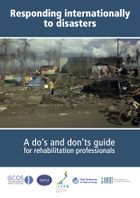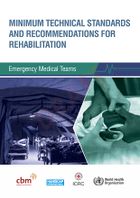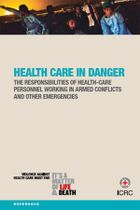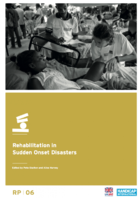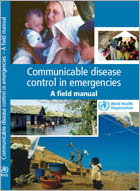Management of Traumatic Brain Injury in Disaster Situations: Difference between revisions
No edit summary |
No edit summary |
||
| Line 20: | Line 20: | ||
{| width="100%" border="1" cellpadding="1" cellspacing="1" | {| width="100%" border="1" cellpadding="1" cellspacing="1" | ||
! rowspan="2" | | ! rowspan="2" |Physiotherapy Rehabilitation Interventions | ||
! colspan="3" |General Applicability of Recommendations in Disaster Settings | ! colspan="3" |General Applicability of Recommendations in Disaster Settings | ||
|- | |- | ||
| Line 72: | Line 72: | ||
* Casts | * Casts | ||
* Simple Orthoses | * Simple Orthoses | ||
|- | |||
|Sleep Disturbance Management | |||
| | |||
| | |||
| | |||
* Sleep Education | |||
* Physical Activity | |||
* Relaxation Therapy | |||
* Modifications Sleep Environment | |||
* Psychological Interventions | |||
* Dietary Modification | |||
|- | |||
|Cognitive Rehabilitation | |||
| | |||
* Assistive Technology | |||
* Structured Experiments | |||
* Game Formats | |||
* Computer-based Treatment | |||
| | |||
* Behavioral Interventions | |||
* Internal Strategies | |||
* Memory Training | |||
* Attention Strategy Training | |||
* Meta-Cognitive Strategies | |||
* Visuospatial Skills Training | |||
| | |||
* Basic Compensatory Memory Strategies | |||
* Direct Feedback | |||
* External Aids | |||
* Learning Techniques | |||
* Group Therapy | |||
* Psychology Interventions | |||
|- | |||
|Behavioural and Emotional Disorders | |||
| | |||
* Social Skills Training | |||
* Peer Mentoring Program | |||
|Comprehensive Neurobehavioural Program | |||
* Contingency Management | |||
* Positive Behavioral Program | |||
| | |||
* Physiotherapy | |||
* Functional Skills Training | |||
* Sleep Education | |||
* Cognitive Behavioral Therapy | |||
* Individual Education | |||
* Family therapy | |||
* Group Therapy | |||
|- | |||
|Activities of Daily Living | |||
| | |||
* Home Assessment and Modifications | |||
* Environmental Assessment and Modifications | |||
| | |||
* Constraint Induced Movement Therapy | |||
* Adaptive Equipment | |||
| | |||
* Guided Practice in ADLs | |||
* Equipment Training | |||
* Caregiver Training | |||
|- | |||
|Post-Traumatic Headache Management | |||
| | |||
* Biofeedback | |||
* Acupuncture | |||
| | |||
| | |||
* Physical Activity | |||
* Relaxation Therapy | |||
* Sleep Education | |||
* Dietary Modification | |||
* Psychological Interventions | |||
|- | |||
|Service Delivery | |||
| | |||
* Social Skills Training | |||
| | |||
* Behavioral Intervention | |||
* Peer Mentoring Program | |||
* Telemedicine | |||
| | |||
* Inpatient Rehabilitation Program | |||
* Home / Community Based Rehabilitation | |||
* Family and Carers Support | |||
|- | |- | ||
|} | |} | ||
Revision as of 01:00, 3 October 2019
Original Editor - Naomi O'Reilly
Top Contributors - Naomi O'Reilly, Kim Jackson, Tony Lowe, Rachael Lowe, Jess Bell and Admin
Introduction[edit | edit source]
Disaster, as defined by the United Nations, is a serious disruption of the functioning of a community or society, which involve widespread human, material, economic or environmental impacts that exceed the ability of the affected community or society to cope using its own resources.[1] According to the International Federation of Red Cross & Red Crescent Societies a disaster occurs when a hazard impacts on vulnerable people. The combination of hazards, vulnerability and inability to reduce the potential negative consequences of risk results in the disaster. [2] While disasters can be caused by nature, the human influence on disasters have been widespread throughout the centuries, particularly in relation to conflict situations. Natural disasters and armed conflict are two of the main types of disasters and have marked human existence throughout history resulting in peaks in mortality and morbidity. [3] Find out more about the different types of disasters and disaster management.
A wide variety of mild, moderate, and severe traumatic brain injury occur secondary to overpressure, penetrating wounds, and crush injuries following the huge kinetic energy released by rapid-onset natural disasters. Disaster preparedness planners and emergency medical personnel face a major challenge in preventing and managing neurotrauma within this context.
Immediate Emergency Care[edit | edit source]
Rehabilitation[edit | edit source]
The World Health Organization (WHO) has developed Emergency Response Frameworks (Standards and Guidelines), which through the Emergency Medical Team Rehabilitation Group have identified the following minimum technical standards and recommendations for rehabilitation following a traumatic brain injury in disasters;
- Cognitive and Neurological changes should be monitored and regularly assessed
- Early referral to a step-down facility using local rehabilitation providers and support networks, as required
- Appropriate mobility aids prescribed for long-term mobility deficits using local service provider
- Patients with long term or permanent nerve injury considered for orthotic device, sought from a local provider
- Referral pathways identified for microsurgery for appropriate patients
| Physiotherapy Rehabilitation Interventions | General Applicability of Recommendations in Disaster Settings | ||
|---|---|---|---|
| Weak | Moderate | Strong | |
| Patient Education |
| ||
| Gait, Balance and Mobility |
|
Task-Specific Training
Repetitive Training |
|
| Spasticity and Muscle Tone |
|
|
|
| Sleep Disturbance Management |
| ||
| Cognitive Rehabilitation |
|
|
|
| Behavioural and Emotional Disorders |
|
Comprehensive Neurobehavioural Program
|
|
| Activities of Daily Living |
|
|
|
| Post-Traumatic Headache Management |
|
| |
| Service Delivery |
|
|
|
Sub Heading 2[edit | edit source]
Add text here...
Disaster Management Guidelines[edit | edit source]
Responding Internationally to Disasters: Do’s and Don’ts
When disasters strike, there is always a huge amount of goodwill from rehabilitation professionals around the world who wish to use their skills to support those affected. This brief guidance informs those who are considering responding internationally to a disaster either as individuals or as part of a team. It highlights key questions to consider before departing, whilst working in the disaster area, and on returning home. Responses to these questions considered are presented as “Do’s and Don’ts” which are exempli ed by recommended practices and those to avoid in the real case studies below. The guidance note is not intended to be a step-by-step or technical guide, nor is it exhaustive, and does not supersede any specific guidance provided by your own global professional body.
Minimum Technical Standards and Recommendations for Rehabilitation: Emergency Medical Teams
This document is the result of collaboration between a working group of rehabilitation experts convened by the World Health Organization and external consultations. It is thus based on a collective experience in rehabilitation during responses to recent large-scale emergencies and also on published data. In time, the minimum standards for rehabilitation in emergencies will be part of a broader series of publications based on the Classification and Minimum Standards for Foreign Medical Teams in Sudden Onset Disaster. The purpose of this document is to extend these standards for physical rehabilitation and provide guidance to Emergency Medical Teams (EMTs) on building or strengthening their capacity for and work in rehabilitation within defined coordination mechanisms.
Rehabilitation in Sudden Onset Disasters
Communicable Disease Control in Emergencies - A Field Manual
Resources[edit | edit source]
International Society of Physical and Rehabilitation Medicine: Disaster Rehabilitation Committee - Role and future agenda Sept 2018
Centers for Disease Control and Prevention, Brain Injuries and Disaster Events Information for Clinicians - List of useful organisations and links
Lee SY, Amatya B, Judson R, Truesdale M, Reinhardt JD, Uddin T, Xiong XH, Khan F. Applicability of traumatic brain injury rehabilitation interventions in natural disaster settings. Brain injury. 2019 Aug 24;33(10):1293-8.
"Many recommendations for TBI care are challenging to implement in disaster settings due to complexities related to the environment, resources, service provision, workforce, and other reasons"
Amatya B, Vasudevan V, Zhang N, Chopra S, Astrakhantseva I, Khan F. Minimum technical standards and recommendations for traumatic brain injury rehabilitation teams in sudden-onset disasters. The Journal of the International Society of Physical and Rehabilitation Medicine. 2018 Apr 1;1(2):72.
"Specialized rehabilitation teams in any disasters are deployed based on the response to meet specific needs required at the request of the host health authorities. These teams should be multidisciplinary and need to be integrated into a disaster response and management plan and their skills need to be shared with local rehabilitation and health-care providers through mentoring and educating/training."
Vasudevan V, Amatya B, Chopra S, Zhang N, Astrakhantseva I, Khan F. Minimum technical standards and recommendations for traumatic brain injury specialist rehabilitation teams in sudden-onset disasters (for Disaster Rehabilitation Committee special session). Annals of Physical and Rehabilitation Medicine. 2018 Jul 1;61:e120.
Regens JL, Mould N. Prevention and treatment of traumatic brain injury due to rapid-onset natural disasters. Frontiers in public health. 2014 Apr 14;2:28
Battlefield and Disaster Nursing Pocket Guide, Ed. by Elizabeth Bridges. Jones & Bartlett, 2009 - guidelines for managing mild through to severe TBI injuries
Veenema TG, editor. Disaster nursing and emergency preparedness. Springer Publishing Company; 2018 Jul 28.
Military Acute Concussion Evaluation 2 (MACE 2)
3 question DVBIC TBI screening tool
Joint Trauma System Clinical Practice Guideline: Neurosurgery and Severe Head Injury (CPG ID:30), Mar 2017
References[edit | edit source]
References will automatically be added here, see adding references tutorial.
- ↑ Cite error: Invalid
<ref>tag; no text was provided for refs namedp4 - ↑ International Federation of Red Cross and Red Crescent Societies. What is a Disaster. http://www.ifrc.org/en/what-we-do/disaster-management/about-disasters/what-is-a-disaster/. [Accessed: 9 Jan 2017]
- ↑ Leaning J, Guha-Sapir D. Natural Disasters, Armed Conflict, and Public Health. New England Journal of Medicine. 2013 Nov 7;369(19):1836-42
